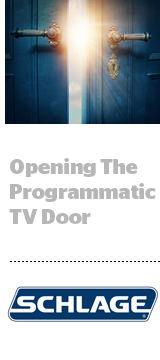
Door hardware maker Schlage was spending seven figures on linear TV advertising.
While the brand still wanted to take advantage of TV’s mass reach, it wanted better targeting, measurement and optimization. So Schlage called on its agency of record, The Basement, and demand-side platform Centro to bring programmatic elements to its TV media buys.
“They said, ‘We can increase your reach, give you more qualified impressions and increase your on-air time,’” said Jason Owens, director of consumer marketing for Schlage.
During CES in Las Vegas this year, The Basement and Centro met with programmatic TV supply-side platform Placemedia, which is owned by cable operator Altice, as well as TV data company Samba TV. The four companies devised a strategy to work together to make Schlage’s linear TV buying more targeted and measurable.
The goal was to use a digital audience to target on linear TV, said Brian Phillips, CEO of The Basement, then create flights that would allow them to optimize and measure performance.
The Basement first identified Schlage’s target audience by aggregating people who have purchased or showed intent to purchase on Schlage’s website, with CRM data. It then indexed that audience against Placemedia’s inventory, which reaches about 100 million US households, created lookalike audiences and bought the TV inventory through Centro.
Once the buys were placed, The Basement used Samba TV to measure viewability and engagement with an ad and optimize based on performance.
“Our impressions became more intelligent because we were using data along the way to measure mid-flight and optimize,” Phillips said. “We would jump to other networks based on the way the audiences were engaging with our advertising.”
Schlage also used Samba TV’s audience sync tool to add a direct-response element to the campaign by serving digital ads on mobile phones that synced with TV ads from Schlage’s retailers.
“We were able to see that an ad aired and then we had specific creative, either display or video, with direct calls to action to channel partners,” Phillips said.
Overall, Schlage saw retail and ecommerce revenue lift 9% and 35% year over year, respectively, from the campaign, and exceeded overall business objectives by 34%. On linear TV specifically, Schlage saw a 2.5% rise in impression delivery and a 3% growth of airtime year over year. The brand, which was spending heavily on one network before, expanded its reach to more than 15 networks.
Schlage will forego future upfronts and other linear traditional TV buys to purchase its inventory in this manner.
“We essentially spent the same amount, but we got a lot more for it, we believe,” Owens said.
Not quite RTB
So what was programmatic about this TV buy?
“When we say programmatic we refer to it from an automation and an audience targeting point of view,” said Chris Satovick, chief operating officer at Placemedia.
Placemedia aggregates linear inventory from MVPDs and cable networks based on the audience and flight requirements for a given campaign. “Whether it’s age and gender, an income target or home ownership, we put together this audience definition and find the inventory that indexes highest for all of those segments,” Satovick said.
The buy, however, is done in a programmatic guaranteed fashion. Placemedia places the buy with the network in real time, but the ad doesn’t run for another few days. Data starts flowing back into Placemedia’s platform within 24 hours of airing.
“Most supply partners need anywhere from a three- to five-day lead time,” Satovick said. “There’s still some latency in the workflow of linear TV based on the fact that there’s disparate technology at the different supply partners.”
Schlage decided to try programmatic TV approach rather than addressable TV because it was looking for a national audience, Satovick said. While the pool of addressable inventory has grown in recent years, it’s still not large enough to target a mass reach campaign.
“The overall distribution is not as great as linear, and when you start to segment it down to a specific audience, it gets much smaller, must faster,” he said. “While Schlage had a few segments they were trying to reach, they were looking to take advantage of a national footprint and do it as efficiently as possible.”
This post was syndicated from Ad Exchanger.

More Stories
M+AD takes break for Anzac Day commemoration
Sustainability Is More Than a Big Leafy Green Picture
Google Won’t Pull Cookies In 2024